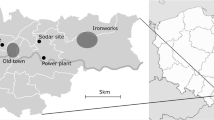Abstract
Samples of background air were collected in thelower troposphere of the Northern (high Arctic,northern Ontario, Vancouver and Houston) andSouthern (Baring Head, New Zealand) Hemispheresover the period July 1999 until March 2001.These samples were analysed for the stablecarbon isotope ratios of1,1,1-trichlorotrifluoroethane (CFC113) andCH3Cl using a gaschromatography-continuous flow on-linecombustion isotope ratio mass spectrometrycombination. For CH3Cl the global averageof the stable carbon isotope ratio is −36.2± 0.3‰ (error of mean). The average isbased on 78 data points, standard deviation forall measurements is 2.3‰, and the 90%confidence interval is −35.8 to −36.6‰.However, the number of data points from theSouthern Hemisphere is rather limited and thusthis observation is not necessarilyrepresentative for the entire SouthernHemisphere. A simple isotopic budget ofCH3Cl shows the most important parametersneeding to be defined are the kinetic isotopeeffect of CH3Cl destruction by OH radicalsand the source composition of CH3Clemitted by the oceans and biomass burning ofC-4 plants. Present budgets of atmosphericCH3Cl show a significant deficit in thesource strength. We estimate that the averagestable carbon isotope ratio of the additionalCH3Cl emissions required to balance thebudget is −41.9 ± 7.8‰. The averageCFC113 isotopic composition based on 38measurements is −23.3 ± 1.6‰ (error ofmean), σ = 9.6‰ with no significantdifference between the hemispheres.
Similar content being viewed by others
References
Andreae MO (1991) Biomass burning: its history, use and distribution and its impact on environmental quality and global climate. In: Levine JS (Ed) Global Biomass Burning. MIT Press, Cambridge, MA
Bill M, Rhew RC, Weiss R& Goldstein A (2002) Carbon isotope ratios of methyl bromide and methyl chloride emitted from a coastal salt marsh. Geophys. Res. Lett. 29(4): 4-1–4-4, DOI 10.1029/2001GL012946
Cantrell CA, Shetter RE, McDaniel AH, Calvert JG, Davidson JA, Lowe DC, Tyler SC, Cicerone RJ& Greenberg JP (1990) Carbon kinetic isotope effect in the oxidation of methane by the hydroxyl radical. J. Geophys. Res. 95: 22455–22462
von Czapiewski K, Czuba E, Huang L, Ernst D, Norman AL, Koppman R& Rudolph J (2002) Isotopic composition of non methane hydrocarbons in emissions from biomass burning. Atmos. Chem. (in press)
Gautrois M, Brauers TH, Koppmann R, Rohrer F, Stein O& Rudolph J (Manuscript in preparation) Seasonal variation and trends of volatile organic compounds in the lower polar troposphere (pers. comm.)
Harper DB, Kalin RM, Hamilton JTG& Lamb C (2001) Carbon isotope ratios for chloromethane of biological origin: potential tool in determining biological emissions. Environ. Sci. Tech. 35: 3616–3619
Intergovernmental Panel on Climate Change (IPCC). Climate Change 1995: Radiative Forcing of Climate Change and an Evaluation of the IPCC IS92 Emission Scenarios. Cambridge University Press, Cambridge, U.K.
Kaplan IR (1975) Stable isotopes as a guide to biogeochemical processes. Proc. Roy. Soc. London, Series B 189: 183–211
Keene WC, Khalil AK, Erickson III DJ, McCulloch A, Graedel TE, Lobert JM, Aucott ML, Gong SL, Harper DB, Kleiman G, Midgley P, Moore RM, Seuzaret C, Sturges WT, Benkovitz CM, Koropalov V, Barrie LA& Li YF (1999) Composite global emissions of reactive chlorine from anthropogenic and natural sources: Reactive Chlorine Emissions Inventory. J. Geophys. Res. 104: 8429–8440
Keppler F, Eiden R, Niedan V, Pracht J& Schoeler HF (2000) Halocarbons produced by natural oxidation processes during degradation of organic matter. Nature 403: 298–301
Khalil MAK, Moore RM, Harper DB, Lobert JM, Erickson DJ, Koropalov V, Sturges WT& Keene WC (1999) Natural emissions of chlorine-containing gases: Reactive Emissions Inventory. J. Geophys. Res. 104: 8333–8346
Khalil MAK& Rasmussen RA (1999) Atmospheric methyl chloride. Atmos. Envir. 33: 1305–1321
Lobert JM, Keene WC, Logan JA& Yevich R (1999) Global chlorine emissions from biomass burning: Reactive Chlorine Emissions Inventory. J. Geophys. Res. 104: 8373–8389
Lowe DC, Brenninkmeijer CAM, Brailsford GW, Lassey KR& Gomez AJ (1994) Concentration and 13C records of atmospheric methane in New Zealand Antarctica: Evidence for changes in methane sources. J. Geophys. Res. 99: 16913–16925
Matthews DE& Hayes JM (1978) Isotope ratio monitoring gas chromatography-mass spectrometry. Anal. Chem. 50: 1465–1473
McCauley SE, Goldstein AH& DePaolo DJ (1999) An isotopic approach for understanding the CH3Br budget of the atmosphere. Proc. Natl. Acad. Sci. U.S.A. 96: 10006–10009
Miller LG, Kalin RM, McCauley SE, Hamilton JTG, Harper DB, Millet DB, Oremland RS& Goldstein AH (2001) Large carbon isotope fractionation associated with oxidation of methly halides by methylotrophic bacteria. Proc. Nat. Acad. Sci. U.S.A. 98: 5833–5837
Mook WG, Koopmans M, Carter AF& Keeling CD (1983) Seasonal latitudinal and secular variations in the abundance and isotope ratios of atmospheric carbon dioxide. J. Geophys. Res. 88: 10915–10933
Moore RM, Groszko W& Niven S (1996) Ocean - atmosphere exchange of methyl chloride: results from NW Atlantic and Pacific Ocean studies. J. Geophys. Res. 101: 28529–28539
Rhew RC, Miller B& Weiss R (2000) Natural methyl bromide and methyl chloride emissions from coastal salt marshes. Nature 403: 292–295
Rudolph J, Lowe D, Martin RJ& Clarkson TS (1997) A novel method for compound specific determination of δ13C in volatile organic compounds at ppt levels in ambient air. Geophys. Res. Lett. 24: 659–662
Rudolph J, Czuba E& Huang L (2000) The stable carbon isotope fractionation for reactions of selected hydrocarbons with OH-radicals and its relevance for atmospheric chemistry. J. Geophys. Res. 105: 29329–29346
Tsunogai U, Yoshida N& Gamo T (1999) Carbon isotopic compositions of C2- C5 hydrocarbons and methyl chloride in urban, coastal, and maritime atmospheres over the western North Pacific. J. Geophys. Res. 104: 16033–16039
Yokouchi Y, Toom-Sauntry D& Barrie LA (1998) Measurements of methyl halides (CH3Cl, CH3Br, CH3I) at Alert. Canadian Baseline Program: Summary of Progress to 1998
Yokouchi Y, Noijiri Y, Barrie L, Toom-Sauntry D, Machida T, Inuzuka Y, Akimoto H, Li H-J, Fujinuma Y& Aoki S (2000) Astrong source of methyl chloride to the atmosphere from tropical coastal land. Nature 403: 295–298
Author information
Authors and Affiliations
Corresponding author
Rights and permissions
About this article
Cite this article
Thompson, A.E., Anderson, R.S., Rudolph, J. et al. Stable carbon isotope signatures of background tropospheric chloromethane and CFC113. Biogeochemistry 60, 191–211 (2002). https://doi.org/10.1023/A:1019820208377
Issue Date:
DOI: https://doi.org/10.1023/A:1019820208377




